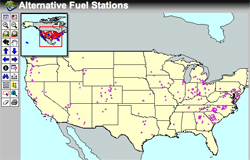Science Blogs
Blogs, magazines, and articles, mostly science and research related.
473 listings
|
Submitted Feb 08, 2006 to Science Blogs » Element FYI  This may come as no surprise to you, particularly if you enjoyed the 50 and 60 degree F temperatures in New York City last month. NOAA reports that the United States had its warmest January on record, with an average temperature of 39.5 degrees F, which is 8.5 degrees F (4.7 degrees C) above the 1895-2005 mean of 31.0 degrees F, according to the NOAA National Climatic Data Center in Asheville, N.C.. January temperatures were even warmer than December of 2005 by as much as 9 degree F in some places. The second warmest January on record was in 1953, which was 2.3 degrees F cooler. As shown in the map here, throughout January 2006, none of the contiguous U.S. experienced below-average temperatures—each state was warmer than the long-term mean. The higher than average temperatures resulted in a record low residential energy demand for the country. NOAA scientists estimate that residential energy demand was 20 percent below average for this time of year. This may come as no surprise to you, particularly if you enjoyed the 50 and 60 degree F temperatures in New York City last month. NOAA reports that the United States had its warmest January on record, with an average temperature of 39.5 degrees F, which is 8.5 degrees F (4.7 degrees C) above the 1895-2005 mean of 31.0 degrees F, according to the NOAA National Climatic Data Center in Asheville, N.C.. January temperatures were even warmer than December of 2005 by as much as 9 degree F in some places. The second warmest January on record was in 1953, which was 2.3 degrees F cooler. As shown in the map here, throughout January 2006, none of the contiguous U.S. experienced below-average temperatures—each state was warmer than the long-term mean. The higher than average temperatures resulted in a record low residential energy demand for the country. NOAA scientists estimate that residential energy demand was 20 percent below average for this time of year. |
|
Submitted Feb 08, 2006 to Science Blogs Science blog covering climate, politics, the environment, and more.
|
|
Submitted Feb 07, 2006 to Science Blogs In a Networked World, There Really Is No-one In Charge. By Earl Mardle.
|
|
Submitted Feb 07, 2006 to Science Blogs » Element FYI  So you now have your new fangled alternative energy car, but where are you going to fill it up? Luckily, the Department of Energy Alternative Fuels Data Center has created a database and website that will help you find alternative fueling stations. The map covers stations for compressed natural gas (CNG), liquefied petroleum gas (LPG or propane), 85% ethanol (E85), electric, biodiesel, hydrogen, and liquefied natural gas (LNG). Just select your fuel type, address, and station search radius. The results are displayed dynamically on an interactive map where you can find more details about each station. The database is continually updated. If you operate a station that isn't included, you can write to webmaster to have it added to the database. So you now have your new fangled alternative energy car, but where are you going to fill it up? Luckily, the Department of Energy Alternative Fuels Data Center has created a database and website that will help you find alternative fueling stations. The map covers stations for compressed natural gas (CNG), liquefied petroleum gas (LPG or propane), 85% ethanol (E85), electric, biodiesel, hydrogen, and liquefied natural gas (LNG). Just select your fuel type, address, and station search radius. The results are displayed dynamically on an interactive map where you can find more details about each station. The database is continually updated. If you operate a station that isn't included, you can write to webmaster to have it added to the database. |
|
Submitted Feb 07, 2006 to Science Blogs » Element FYI We've added a new category on Element List just for science podcasts from around the web. You can find links to such sources as the Berkeley Groks Science Show to Science @ NASA to the new New York Times Science Update and more. You can add your science podcast link by submitting it here.
|
|
Submitted Feb 05, 2006 to Science Blogs » Element FYI  Spiked magazine polled over 250 scientists with the question, "If you could teach the world just one thing about science, what would it be?" The survey was conducted to mark the 2005 World Year of Physics, which celebrates Einstein's "miraculous year" in 1905 in which he developed the theory of special relativity. The answers covered many areas of science, only a few actually related to Einstein's theories. "The scientific principle that I wish everyone understood," said Richard Dawkins (pictured right), from the University of Oxford, "is Darwinian natural selection, and its enormous explanatory power, as the only known explanation of 'design'." Gerald Jay Sussman of MIT, responded with a quote from Galileo, "In questions of science, the authority of a thousand is not worth the humble reasoning of a single individual." The originator of the survey, Alom Shaha, has made four films containing interviews with the scientists as they explain their "most important lesson." Spiked magazine polled over 250 scientists with the question, "If you could teach the world just one thing about science, what would it be?" The survey was conducted to mark the 2005 World Year of Physics, which celebrates Einstein's "miraculous year" in 1905 in which he developed the theory of special relativity. The answers covered many areas of science, only a few actually related to Einstein's theories. "The scientific principle that I wish everyone understood," said Richard Dawkins (pictured right), from the University of Oxford, "is Darwinian natural selection, and its enormous explanatory power, as the only known explanation of 'design'." Gerald Jay Sussman of MIT, responded with a quote from Galileo, "In questions of science, the authority of a thousand is not worth the humble reasoning of a single individual." The originator of the survey, Alom Shaha, has made four films containing interviews with the scientists as they explain their "most important lesson." |
|
Submitted Feb 05, 2006 to Science Blogs Lew Rockwell, founder and president of the Mises Institute in Auburn, Ala., and vice president of the Center for Libertarian Studies in Burlingame, Cal., is an opponent of the central state, its wars and its socialism. LewRockwell.com highlights the news and commentary that he finds important, or simply interesting. It is therefore unapologetically idiosyncratic.
|
|
Submitted Feb 01, 2006 to Science Blogs » Element FYI
|
|
Submitted Feb 01, 2006 to Science Blogs » Element FYI  Pardon me Element Listers, for I know that I've been absent from the blogosphere lately. I blame a bad head cold that hit me last Thursday, which makes thinking and websurfing not as fun or fast as usual. Anyway, it seems that the blogosphere is abuzz with comments about Andrew Revkin's article in the NY Times regarding the Bush Administration's latest attempt to silence any government employee who dares to admit that global warming is real or a threat, least of all climate expert and director of NASA's Goddard Institute for Space Studies in New York City, James Hansen. According to Revkin, "The scientist, James E. Hansen, longtime director of the agency's Goddard Institute for Space Studies, said in an interview that officials at NASA headquarters had ordered the public affairs staff to review his coming lectures, papers, postings on the Goddard Web site and requests for interviews from journalists." Now, Scientific American editor John Rennie, has taken Kevin Vranes of No Se Nada blog - and (fellow) Ph.D. graduate of the Department of Earth and Environmental Sciences at Columbia University where Hansen is an adjunct faculty member - to task for his comment that Hansen went too far in advocating a particular response to observed global warming. (I'd be interested to know if Kevin ever took a class from Hansen.) I'm not going to get into the particulars of the debate here, except to provide links - like this one on drowning polar bears and this one on the Bush Admin's record of ignoring science - and point out that you know you've hit it big when the mainstream science media take the time to mention your blog, much less criticize your blog. It warms my heart to see young bloggers swinging bats with the big guys. Go get 'em, bloggers. Pardon me Element Listers, for I know that I've been absent from the blogosphere lately. I blame a bad head cold that hit me last Thursday, which makes thinking and websurfing not as fun or fast as usual. Anyway, it seems that the blogosphere is abuzz with comments about Andrew Revkin's article in the NY Times regarding the Bush Administration's latest attempt to silence any government employee who dares to admit that global warming is real or a threat, least of all climate expert and director of NASA's Goddard Institute for Space Studies in New York City, James Hansen. According to Revkin, "The scientist, James E. Hansen, longtime director of the agency's Goddard Institute for Space Studies, said in an interview that officials at NASA headquarters had ordered the public affairs staff to review his coming lectures, papers, postings on the Goddard Web site and requests for interviews from journalists." Now, Scientific American editor John Rennie, has taken Kevin Vranes of No Se Nada blog - and (fellow) Ph.D. graduate of the Department of Earth and Environmental Sciences at Columbia University where Hansen is an adjunct faculty member - to task for his comment that Hansen went too far in advocating a particular response to observed global warming. (I'd be interested to know if Kevin ever took a class from Hansen.) I'm not going to get into the particulars of the debate here, except to provide links - like this one on drowning polar bears and this one on the Bush Admin's record of ignoring science - and point out that you know you've hit it big when the mainstream science media take the time to mention your blog, much less criticize your blog. It warms my heart to see young bloggers swinging bats with the big guys. Go get 'em, bloggers. |
|
Submitted Jan 31, 2006 to Science Blogs In which a veteran of cultural studies seminars in the 1990's moves into academic administration and finds himself a married suburban father of two. Foucault, plus lawn care.
|
|
Submitted Jan 29, 2006 to Science Blogs A science blog by seismology Professor Bill Menke at Columbia University.
|
|
Submitted Jan 27, 2006 to Science Blogs » Element FYI  Einstein "Enlightening Ideas": In this animated video, Einstein explains his special theory of relativity. Interactive animations allow the user to assimilate the concepts underlying this theory. Einstein "Enlightening Ideas": In this animated video, Einstein explains his special theory of relativity. Interactive animations allow the user to assimilate the concepts underlying this theory.
Linus Pauling and the Race for DNA: The Valley Library at Oregon State University contains over 800 scanned documents, photographs, audio clips, and videos about the discovery of DNA. Watch scientific luminaries Francis Crick, James Watson, Linus Pauling, and Maurice Wilkins describe their roles in the race for the discovery of the double helix structure of DNA. James Watson admits that early on "DNA was a word. It never meant anything as a molecule to me, and I knew it was composed of nucleotides. But again, except for an exam, I never would have learned what the formula was." Dive and Discover Return to the Galapagos Rift: Dive and Discover is a multimedia site hosted by the Woods Hole Oceanographic Institution that is designed to immerse you in deep seafloor expeditions to study deep sea vents and fauna. In the most recently profiled expedition, Return to the Galapagos Rise, researchers use the submarine Alvin to study organisms that live off of heat and gases that rise out of the Galapagos Spreading Center in the Pacific Ocean. The site contains video clips from each expedition, such as the one shown at right, in which Alvin divers spotted an octopus. |
|
Submitted Jan 26, 2006 to Science Blogs » Element FYI  What's more fun than reading an encyclopedia? Writing one, apparently. Wikipedia is now more than three times the size of the online Encyclopedia Britannica, and growing everyday thanks to its authorship by people from around the world. There's also a new section called Wikispecies that is designed to be an open, free directory covering all species that users are willing to happily type into the database. The database also contains plenty of pictures of various species. Want to read up on Fungi like those pictured right? Click here. Want to discuss edits with other wiki users? Go to the Village Pump. Or maybe you don't like the Wikispecies logo. You can go here to propose a new one. Bored and looking for a new species to write about? Go to the done and to do page. It's almost as fun as collecting your own spores, molds, and fungus. What's more fun than reading an encyclopedia? Writing one, apparently. Wikipedia is now more than three times the size of the online Encyclopedia Britannica, and growing everyday thanks to its authorship by people from around the world. There's also a new section called Wikispecies that is designed to be an open, free directory covering all species that users are willing to happily type into the database. The database also contains plenty of pictures of various species. Want to read up on Fungi like those pictured right? Click here. Want to discuss edits with other wiki users? Go to the Village Pump. Or maybe you don't like the Wikispecies logo. You can go here to propose a new one. Bored and looking for a new species to write about? Go to the done and to do page. It's almost as fun as collecting your own spores, molds, and fungus. |
|
Submitted Jan 23, 2006 to Science Blogs » Element FYI  Every month the International Research Institute for Climate and Society at Columbia University publishes the IRI Climate Information Digest, an online publication that covers recent climate anomalies around the globe and their societal impacts with an emphasis on climatic hazards, health, energy/water resources, and agriculture. The articles provide context for IRI seasonal climate forecasts and El Nino-Southern Oscillation updates, which can also be found on the site. This month's hot topics: Every month the International Research Institute for Climate and Society at Columbia University publishes the IRI Climate Information Digest, an online publication that covers recent climate anomalies around the globe and their societal impacts with an emphasis on climatic hazards, health, energy/water resources, and agriculture. The articles provide context for IRI seasonal climate forecasts and El Nino-Southern Oscillation updates, which can also be found on the site. This month's hot topics: |
|
Submitted Jan 22, 2006 to Science Blogs » Element FYI
|
|
Submitted Jan 21, 2006 to Science Blogs On the cross-fertilization of geospatial and semantic web technology.
|
|
Submitted Jan 21, 2006 to Science Blogs I started Daily Kos on May 26, 2002 (named after my Army nickname, rhymes with "prose"), and continue to maintain the site from Berkeley, California.
|
|
Submitted Jan 21, 2006 to Science Blogs Megnut is the personal blog of Meg Hourihan. Meg co-founded the company that created Blogger (now owned by Google). This site is updated several times a week, and has been since May, 1999. General topics of interest include food, travel, technology, and women's rights.
|
|
Submitted Jan 21, 2006 to Science Blogs Science, culture, politics, policy, and media. By Kevin Vranes.
|
|
Submitted Jan 20, 2006 to Science Blogs » Element FYI  Too many people fail to recognize that scientific research is itself a creative endeavor, where scientists toil endlessly on problems without easy or obvious solutions. Over 30 years ago, legendary musician and music producer Brian Eno and his friend Peter Schmidt created a deck of cards called Oblique Strategies, which is meant to be used when you find yourself in a creative block. While meant for artists, the Oblique Strategies suggestions are general enough to work for scientific or any other kind of problem solving. Now the deck is available online as a downloadable widget for your Mac OS X Dashboard, PC, or PalmPilot. If you're stuck, say, trying to debug a program or finish a paper, you can just pull a card (real or virtual) for some inspiration, such as "Be extravagant" or "Retrace your steps." (via Cool Tools) Too many people fail to recognize that scientific research is itself a creative endeavor, where scientists toil endlessly on problems without easy or obvious solutions. Over 30 years ago, legendary musician and music producer Brian Eno and his friend Peter Schmidt created a deck of cards called Oblique Strategies, which is meant to be used when you find yourself in a creative block. While meant for artists, the Oblique Strategies suggestions are general enough to work for scientific or any other kind of problem solving. Now the deck is available online as a downloadable widget for your Mac OS X Dashboard, PC, or PalmPilot. If you're stuck, say, trying to debug a program or finish a paper, you can just pull a card (real or virtual) for some inspiration, such as "Be extravagant" or "Retrace your steps." (via Cool Tools) |


















